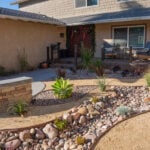In recent years, the term “astroturfing” has expanded its definition beyond the realm of creating artificial grassroots movements or generating fake online support. It has found a new place in the world of landscaping—specifically, as a popular solution for transforming traditional grass lawns into synthetic turf alternatives. Astroturf, a brand name that became synonymous with artificial grass, has now evolved into a generic term representing artificial turf used in various settings, including residential yards. There are several debatable questions surrounding artificial turf installation, including its benefits, drawbacks, and environmental implications. Artificial turf replaces actual grass in yards.
What is Astroturf?
Artificial turf, often known as synthetic grass or astroturf, is a synthetic surface that imitates natural grass. Its composition typically consists of polyethylene, nylon, and polypropylene. The evolution of synthetic grass has made it more realistic in appearance, with varying blade lengths, colors, and textures. Initially developed for sports fields, its application has expanded to residential landscaping due to its low maintenance requirements and ever-improving visual appeal.
Pros of Astroturfing Your Yard
Low Maintenance
One of the primary reasons homeowners opt for astroturf is its minimal upkeep. Artificial turf takes very little upkeep in comparison to actual grass, which needs to be mowed, watered, fertilized, and weeded. It requires no watering nor mowing, nor do pesticides or herbicides come into play.
Consistent Appearance
Astroturf offers a consistent and visually appealing green space throughout the year. It remains lush and green regardless of weather conditions, making it an attractive option in regions with harsh climates where natural grass struggles to thrive.
Durability
Synthetic turf is highly durable and can withstand heavy foot traffic and pet activities without showing wear and tear. Its resilience makes it an excellent choice for families and pet owners seeking a robust outdoor surface.
Water Conservation
In a world increasingly affected by water scarcity, astroturf can be considered an eco-friendly option due to its minimal water requirements. While natural grass demands significant water resources to maintain its health, artificial grass helps conserve water, contributing to overall water conservation efforts.
Drawbacks of Astroturf
Heat Retention
One of the significant concerns with artificial turf is its tendency to retain heat. In warmer climates, synthetic grass can become excessively hot, making it uncomfortable to walk on during peak temperatures. This issue can be mitigated to some extent by choosing lighter-colored turf or implementing cooling solutions.
Initial Cost and Installation
The upfront cost of installing artificial turf can be relatively high, including the price of the turf itself, labor, and groundwork preparation. For a larger yard, the expense can be substantial. Despite the potential for long-term savings in maintenance costs, the initial investment can be a deterrent for some homeowners.
Environmental Impact
Astroturf is produced using non-biodegradable ingredients, even though it can save water and use less hazardous chemicals. There are also issues with how synthetic turf should be disposed of after its useful life and how it affects landfills. Efforts are being made to improve the recyclability of artificial grass, but it remains an ongoing challenge.
Environmental Considerations
The environmental impact of astroturfing your yard is a topic of increasing importance. Although synthetic grass can help save water and cut back on the usage of dangerous chemicals, non-renewable resources are used in its creation. Concerns over the long-term effects on the environment are raised by the disposal of synthetic turf at the end of its useful life. To mitigate these issues, ongoing research focuses on developing more sustainable materials for artificial turf. Therefore, improving the recyclability of existing products.
A Personal Choice
In the end, the choice to artificially grass your yard is subjective and impacted by a number of variables. Based on their unique demands, geography, and environmental concerns, homeowners should assess the benefits and drawbacks. Synthetic turf may have more advantages than disadvantages in regions with limited water supplies or harsh weather. However, for individuals prioritizing a natural aesthetic, environmental consciousness, or with concerns about initial costs, maintaining a traditional grass lawn might be the preferred choice.
Exploring the Future of Astroturfing
Astroturfing your yard presents a viable solution for homeowners seeking low-maintenance, visually appealing green spaces. While it offers benefits such as low upkeep, consistency in appearance, and water conservation, it’s essential to consider the drawbacks, including initial costs, heat retention, and the environmental impact of non-biodegradable materials. As technology and sustainable practices evolve, the development of more eco-friendly synthetic turf options remains a focus. Hence, it aims to address concerns about environmental impact.
Ultimately, the decision to astroturf your yard involves balancing personal preferences, environmental considerations, and practical needs. The evolving landscape of synthetic turf continues to shape the conversation around sustainable landscaping practices. Therefore, prompting a deeper exploration of its benefits and drawbacks in creating a green space for the future.






